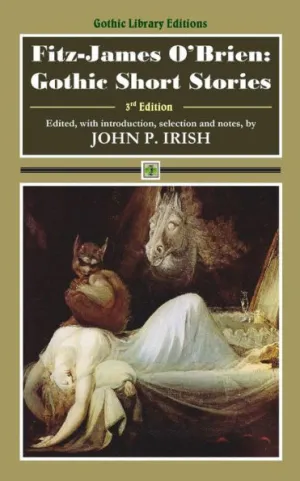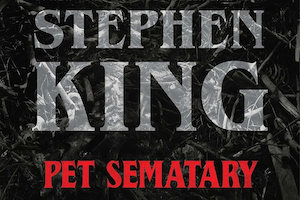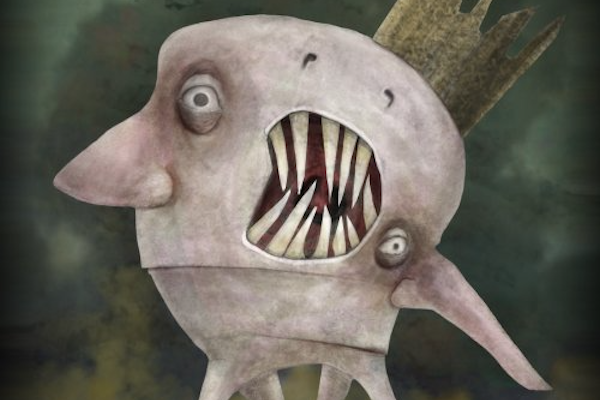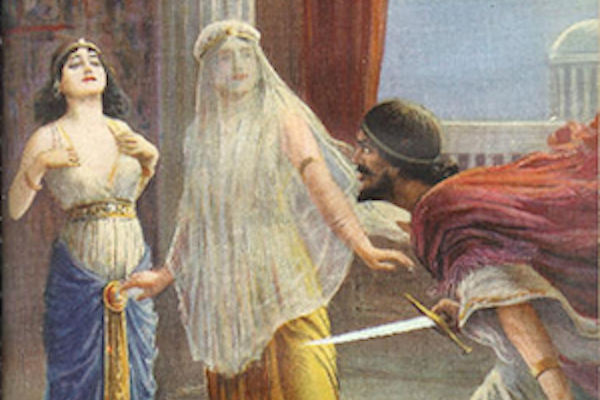Welcome back to Reading the Weird, in which we get girl cooties all over weird fiction, cosmic horror, and Lovecraftiana—from its historical roots through its most recent branches.
This week, we cover Fitz-James O’Brien’s “What Was It? A Mystery,” first published in the March 1859 issue of Harper’s New Monthly Magazine. Spoilers ahead!
“Yes, I had one arm firmly clasped around a breathing, panting, corporeal shape, my other hand gripped with all its strength a throat as warm, and apparently fleshly, as my own; and yet, with this living substance in my grasp, with its body pressed against my own, and all in the bright glare of a large jet of gas, I absolutely beheld nothing!”
Our narrator, Harry, warns us that he expects his account “to meet with an unusual amount of incredulity and scorn.” Fortunately, he has “the literary courage to face unbelief.”
The incident occurred “July last” [circa 1858, let’s say, given the publication date of the story], shortly after Harry moved into No. ___, 26th Street, New York. The house is a “large and stately residence, surrounded by what was once a garden, but which is now only a green enclosure used for bleaching clothes.” It was built by a well-known New York merchant who committed bank fraud and fled to Europe. Caretakers have reported “unnatural noises,” doors that open without “visible agency,” furniture rearranged overnight, invisible feet passing up and down the grand spiral stairs. Rumors of the haunting have discouraged all potential buyers.
Mrs. Moffat, Harry’s landlady at a Bleeker Street boarding-house, wants to move uptown and sees the abandoned mansion as a good opportunity. The supposed haunting is for her “plucky and philosophical” boarders more inducement than deterrent. Only two “timid” characters, a sea-captain and former prospector, decline. The rest enjoy their spacious “abode of spirits” and its pleasant location on the banks of the Hudson. They eagerly await ghostly encounters, but pass an initial supernatural-free month nothing supernatural manifests. The butler says something invisible blew out his candle, but Harry attributes this perception to the man’s habitual inebriation.
Speaking of inebriation, Harry and his friend Dr. Hammond often repair to the garden for pipes of opium-laced tobacco. They converse on cheerful topics and the sunny side of Eastern exoticism so their “unimaginable spiritual bliss” isn’t tainted by fear. But one July evening a “strange perversity” drags their thoughts into darker territory. Suddenly Hammond asks, “What do you consider to be the greatest element of terror?” Harry’s experienced plenty of mundane terrors, but what could be “the ruling embodiment of fear”? He confesses he has no clue. Hammond feels the answer may lie in “something combining in fearful and unnatural amalgamation hitherto supposed incompatible elements.”
Harry breaks off the morbid conversation and goes to bed. He turns down the gaslight so the room is in darkness and struggles for sleep. Before he can achieve it, “Something” drops onto his chest. Bony hands seize his throat.
A terrible struggle ensues. The unseen attacker, slickly naked, biting with sharp teeth and gripping with “sinewy, agile hands”, requires all Harry’s strength to subdue. At last he pins it to the floor and ties its arms with a handkerchief. So far, he’s proud to have raised no alarm. Then he turns up the gaslight and shrieks to find that his panting, warm, corporeal foe is totally invisible!
The household piles into Harry’s room. All but Hammond suppress laughter at Harry’s apparent mime act, holding a creature none can see. Hammond touches the nothingness Harry indicates, and feels it too.
The friends bind the Thing with rope and demonstrate its reality to the others by dropping it onto a bed that creaks, a mattress and pillow that yield as to a body. All rush away, leaving Harry and Hammond alone with the Mystery. Hammond reasons that the combination of invisibility with tangibility is what overwhelms them. But take glass. Theoretically you could make it so transparent as to be invisible, but you could still touch it. And spiritualists conjure invisible but tangible presences.
Tied to Harry’s bed, the Thing struggles for freedom. The friends bring in a doctor to anesthetize it with chloroform, allowing a plaster mold. The resulting facsimile is man-shaped though distorted, under five feet, with “unparalleled” muscular development. Its face is hideous, like something “capable of feeding on human flesh.”
The practical conundrum: how they can keep such a beast in the boarding-house, yet how can they release something so dangerous into the world? Mrs. Moffat threatens to sue if they don’t get rid of the Thing; they suggest it’s her responsibility as landlord. But Moffat can’t find anyone to remove the Mystery, so Harry and Hammond are stuck with a prisoner slowly starving – it won’t touch any food they offer.
A fortnight passes with the Thing’s breathing and heartbeat daily weakening. The “terrible life-struggle” of even this monster rouses Harry’s pity, leaving him sleepless. Finally one morning Hammond and Harry find the Thing without breath or heartbeat. They hurriedly bury it in the garden and give its cast to a museum.
Harry is now going on “a long journey from which [he] may not return.” He leaves behind this “narrative of an event the most singular that has ever come to [his] knowledge.”
The Degenerate Dutch: The household has a “black butler” who is often “in a condition when one candle must have appeared to him like two,” and whose reports of mysteriously extinguished candles can therefore not be trusted. This, shared by someone with the “secret vice” of smoking opium. And who avoids bad trips through orientalist fantasies of “the east,” which is for sure an effective strategy that makes his reports totally trustworthy.
We never do find out how the “colored gentleman” responds to the actual discovery of the actual monster.
Libronomicon: Literary references abound, along with the suggestion that maybe, just maybe, reading about the occult is not perfect preparation for experiencing it. One boarder purchases Mrs. Crow’s Night Side of Nature “for his own private delectation.” Housemates keep stealing it when he puts it down. And the narrator once wrote a ghost story for Harpers. Other shoutouts include Brockden Brown’s Wieland, Hoffman’s work, Goudon’s History of Monsters, and Bulwer’s (the famous Bulwer-Lytton’s?) Zanoni.
More artistic references for the horrible plaster-cast face: Gustave Dorè, and Tony Johannot’s illustration of Un Voyage Ou Il Vous Plaira. The latter is included in Fitz-James O’Brien: Gothic Short Stories, and unfortunately looks like a somewhat Brian Froud-ish garden gnome.
Madness Takes Its Toll: Quoth narrator, after wrestling his monster to the ground and discovering that it’s invisible, “I wonder that I did not faint or go mad on the instant.”
Anne’s Commentary
I don’t know how we missed discussing Fitz-James O’Brien in this blog, particularly back when we were fine-combing Supernatural Horror in Literature for earlier writers Lovecraft admired. In his monograph, Lovecraft notes that O’Brien was “among the earliest of Poe’s disciples.” O’Brien emigrated from Ireland to New York, where he became a frequent contributor to such publications as Harper’s Magazine, wrote plays, and joined a Bohemian set among whom he ranked as one of the most brilliant and entertaining. His career was cut short by the Civil War, in which he served as a Union soldier. O’Brien’s untimely death, Lovecraft notes, “undoubtedly deprived us of some masterful tales of strangeness and terror, though his genius was not, properly speaking, of the same titan quality which characterised Poe and Hawthorne.”
Okay, no titan, but pretty good. Lovecraft singles out today’s tale as “the first well-shaped short story of a tangible but invisible being.” It preceded de Maupassant’s “Horla” (1887) and Bierce’s “Damned Thing” (1893) by several decades. Bierce responded to accusations that he plagiarized O’Brien’s Thing by calling it “supernatural and impossible,” whereas his Thing is scientifically plausible as an animal that’s evolved into a color invisible to the human eye. I guess it didn’t occur to Bierce that such an animal would not have remained invisible when muddy or dusty, or limned by a clinging coat of rain or snow or mist, or spattered with a victim’s blood. O’Brien’s Dr. Hammond does try to “scientifically” explain the Mystery – well, what about a “not theoretically impossible” sheet of glass that would reflect no light, but only refract it like the air does? Harry counters, as he should, that glass is inanimate, a much simpler collection of atoms than an animate being. In The Invisible Man (1897), H. G. Wells’s optics expert Griffin expounds on the reflective and refractive properties of glass and air at much greater length than Hammond and acknowledges like Harry the difficulties of dealing with animate beings versus inanimate constructs – the former are so damned lousy with essential pigments, like the pervasive red of their blood!
Griffin, himself gifted with an albino’s relative freedom from pigments, figures out how to remove the red from blood without changing its functions, and voila, an invisible man! (Insert some serious suspension of disbelief here. At least Wells realizes a necessarily naked invisible man must get awfully cold, as well as lose invisibility when dirty, wet, bloody, etc.)
When challenged, Hammond blows his science creds by falling back on the phenomena associated with spiritualism, but O’Brien quickly drops this line of inquiry. The friends investigate the Mystery as a material being rather than a ghost. Their efforts are confined to its tangible and external aspects. The Thing’s not visible in itself, so there goes sight. It appears to make no sound but panting, no cries, no speech. There goes hearing. If it emits any odors, they’re not mentioned. Goodbye, smell. Goodbye taste, too, since the friends (probably wisely) refrain from licking their subject.
Overall, Harry and Hammond make better opium-dreamers than scientists. They don’t keep the Mystery much of a secret, given they bring in another doctor to anesthetize it and a modeler to cast it, then donate its cast to a museum after it dies. They might have done better to donate its corpse to a medical college or other scientific institution, where samples could have been taken, an autopsy done. Better still, they might have passed on the living Thing to an experienced zookeeper. The friends place various foodstuffs before their captive, but there’s no mention of freeing its hands or bringing the food to its mouth, so how’s it supposed to chow down?
Given how it attacked Harry, maybe its preferred nourishment is human flesh and blood. It does have that ghoulish visage, after all.
The titular question remains unsolved, as was O’Brien’s intention: What was it? An ethereal entity that’s been haunting this house all along, somehow rendered material by Harry’s morbid state of mind? The inhabitant of another dimension slipped through a portal in Harry’s ceiling? A mis-teleported space alien? Or was the whole incident the product of Harry’s opium-addled brain, and is his journey of maybe-no-return to an asylum?
The Lovecraft story O’Brien’s reminds me of most is “The Unnamable,” in which two friends argue over whether there could be anything so abhorrent, so beyond human comprehension, as to defy attempts to name it: a true “King of Terrors” as Harry puts it. Like Harry and Hammond, they get an ambiguous but emotionally compelling answer, allusively described by Lovecraft’s Joe Manton as “a gelatin – a slime – yet it had shapes, a thousand shapes of horror beyond all memory. There were eyes – and a blemish. It was the pit – the maelstrom – the ultimate abomination.”
So…what was it, Joe? And, Harry, can’t you give your visitor a better name than the Thing and the Mystery? In both cases, the answer’s “I don’t know,” and perhaps that’s best for all concerned.
Ruthanna’s Commentary
People will do almost anything for affordable housing in New York. There are worse options than a haunted house. So much the better if you’re a “plucky and philosophical” tenant who enjoys speculating about the occult and wouldn’t mind a few clanking chains of your own. Unless you’re one of the exceptions: the “timid” ship’s captain and returnee from California’s wild west, both of whom have presumably had enough of adventures already.
And then, where are the ghosts? We want the ghosts we signed up for! A whole unhaunted month, no fair. We ought to get a discount on our rent!
Mrs. Moffat’s haunted boarding-house is located in modern-day Chelsea, about two blocks from the High Line, and has since been torn down to make room for the Fashion Institute of Technology. Desirable real estate indeed! It’d also be a short walk to Tor’s old digs in the Flatiron if it weren’t 50 years too early.
The inclusion of such a specific locale reminds me of another famous address at 21b Baker Street, made known to the public 28 years later. I’ve been rereading early Holmes stories this week, and thinking about the surprisingly fine line between superstition and evidence-based reasoning. Holmes, after all, is often half-jokingly accused of witchcraft, and his reasoning depends on assumptions about the predictability of human life that we now know to be false. And his author (who hated him) was extremely prone to seeing evidence for the supernatural where fraud or mundane ambiguity were the true explanations.
O’brien plays with this line in “What Was It?” The narrator acts rational and scientific. He doesn’t freeze when attacked in the night, but subdues and binds his assailant. For many, this might be the scariest part, reminiscent of night terrors and the classic demon sitting on one’s chest (which of course has a rational scientific explanation). And yet, he’s only frightened when he turns up the gaslamp and can’t see the thing. His fellow “adventurers” refuse to touch it; only his companion-in-drugs is willing to help tie it up.
Yet there’s little question of it being an opium delusion. (Narrator, stop smoking opium while trying to collect data!) The others can see the ropes wrapped around the invisible creature, can hear and see the effect when it’s dropped on the bed. They’re terrified enough to flee the low-rent premises. They wanted clanking chains and apparitions; invisible-yet-tangible monsters are too much. My dudes, these are the ghosts you signed up for!
So the point at which the monster is dangerous completely fails to overlap with the point at which it’s horrifying. Indeed, once bound the creature itself is fully at their mercy. Chloroform renders it unconscious; a plaster mold is easily taken. It needs food but won’t eat anything they provide. Eventually it starves to death, which you must admit is an extremely un-ghostly thing to do. They bury it in the garden, presumably there to frighten whoever comes along a few years later to install plumbing pipes.
I feel like this is one of those stories that suffers from intervening years and trope development. “The monster can be tied up and measured, but not seen” just doesn’t do it for me as “the greatest element of terror.” And having everyone but the opium-smokers refuse to touch it feels like a cop-out rather than clever ambiguity. But it’s the trope-founder; naturally it’s going to feel underdone compared to Lovecraft’s “Unnamable” or Bierce’s “Damned Thing,” let alone later writers who know they can’t invoke shivers with imperceptibility alone.
What I, a 21st Century reader, would’ve particularly liked here is some vague thematic connection between the monster and the house’s history. The original owner fled the country to avoid prosecution for bank fraud! The landlady argues with them about whose responsibility it is to remove the monster! And yet somehow that monster has nothing to do with the excesses of capitalism. Even if it does have an invisible hand.
Next week, join us as we dive into our next longread: Chapter 1 of Hilary Mantel’s Beyond Black.
Ruthanna Emrys’s A Half-Built Garden is now out! She is also the author of the Innsmouth Legacy series, including Winter Tide and Deep Roots. You can find some of her fiction, weird and otherwise, on Tor.com, most recently “The Word of Flesh and Soul.” Ruthanna is online on Twitter and Patreon, and offline in a mysterious manor house with her large, chaotic, multi-species household outside Washington DC.
Anne M. Pillsworth’s short story “The Madonna of the Abattoir” appears on Tor.com. Her young adult Mythos novel, Summoned, is available from Tor Teen along with sequel Fathomless. She lives in Edgewood, a Victorian trolley car suburb of Providence, Rhode Island, uncomfortably near Joseph Curwen’s underground laboratory.













